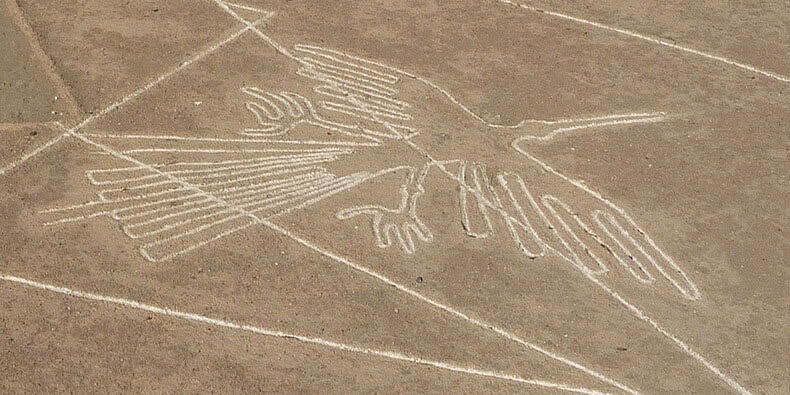In the dry, wind-swept coastal plains of southern Peru, roughly 250 miles south of the bustling capital city of Lima, lies one of the most mysterious and awe-inspiring archaeological marvels in human history: the Nazca Lines. For more than a century, these massive geoglyphs have puzzled scientists, inspired artists, and captivated the imaginations of all who encounter them. Sprawling across nearly 170 square miles of desert terrain, the Nazca Lines remain one of the greatest enigmas of the ancient world.

These incredible ground drawings, etched into the earth more than 2,000 years ago, are not merely random shapes or simple markings. Instead, they represent an astonishing variety of designs—more than 800 straight lines, numerous geometric patterns such as spirals, trapezoids, and zigzags, and over 70 representations of living beings. Among the most iconic are the depictions of animals like a spider, hummingbird, monkey, condor, and whale, some stretching up to 1,200 feet in length. The scale of these designs is so grand that they can only truly be appreciated from high above, which has added to the enduring mystery surrounding their creation and purpose.
Recent technological advances, including the use of drones and satellite imaging, have allowed archaeologists to discover even more geoglyphs, some hidden beneath centuries of sand and erosion. Among these new findings are scenes that depict rituals, including one image thought to represent decapitation, and another portraying a fantastical creature nearly 100 feet long that resembles a blend of known and mythical animals. These additions have deepened the intrigue and have given rise to fresh discussions about the beliefs and practices of the people who created them.
Most scholars agree that the Nazca Lines were primarily the work of the Nazca civilization, which thrived in the region from about 100 B.C. to A.D. 700. However, some of the earliest lines may have originated during the time of the Paracas and Chavin cultures, suggesting that the tradition of geoglyph-making evolved over several centuries. What is particularly remarkable about these ancient artists is the method by which they created such vast and precise images without the benefit of aerial perspective. By removing the sun-darkened, oxidized stones from the desert surface and revealing the lighter-colored sand beneath, the Nazca people produced lines that have survived for more than two millennia, thanks largely to the region’s extremely dry climate and lack of wind.
The purpose behind these monumental figures remains a topic of spirited debate and research. Some of the earliest theories suggested that the lines functioned as a massive astronomical calendar, aligning with solstices or star movements. Others, more fantastical in nature, speculated that the figures were landing strips for alien visitors or extraterrestrial spacecraft, a theory that gained popularity through books and television in the 20th century. While such ideas continue to capture the public’s imagination, recent scientific studies have pointed to more grounded interpretations. Many researchers now believe the geoglyphs were part of religious ceremonies and water-related rituals. Given the harsh and arid conditions of the Nazca Desert, it is likely that water was central to the people’s survival and spiritual beliefs. The lines may have served as offerings to their deities, constructed to invoke rain and ensure agricultural fertility in an otherwise unforgiving environment.
Despite their remarkable endurance over the centuries, the Nazca Lines are not immune to modern threats. In recent years, portions of the geoglyphs have suffered damage due to unexpected rainfall and flooding—rare but devastating natural events in the region. Human activity has posed an even greater threat. In 2014, the global community was shocked when a well-known environmental organization caused significant harm to the lines by staging a protest that left permanent damage. Careless drivers, including one truck driver in 2018 who illegally entered the protected area, have also left destructive tire marks across sections of the ancient figures. These incidents highlight the urgent need for increased conservation measures and greater public awareness about the importance of preserving cultural heritage.
Efforts are currently underway to strengthen protections for the Nazca Lines. UNESCO declared the site a World Heritage Site in 1994, acknowledging its immense value to humanity. Local and international archaeologists continue to collaborate on preservation strategies, including enhanced surveillance, visitor education programs, and the development of sustainable tourism that allows people to witness the majesty of the geoglyphs without contributing to their degradation. Technology is also playing a critical role in these conservation efforts, enabling researchers to map, monitor, and analyze the lines without setting foot on the fragile desert surface.
The Nazca Lines stand as a silent testament to the creativity, dedication, and spiritual depth of an ancient civilization that once flourished in one of the most desolate regions on Earth. Their sheer scale and beauty speak to a profound connection between people and the land, between ritual and survival. They compel us to look back in time with wonder, urging us to understand not only how they were made, but why.
As we continue to study the Nazca Lines with modern tools and fresh perspectives, they remind us of the ingenuity of our ancestors and the importance of preserving the remnants of human history. These immense figures, carved into the desert floor, are more than just archaeological artifacts—they are voices from the past, calling out across the centuries with stories still waiting to be fully told. In honoring and protecting them, we honor the enduring legacy of the people who shaped them and ensure that future generations will also have the opportunity to marvel at one of the world’s greatest ancient wonders.





